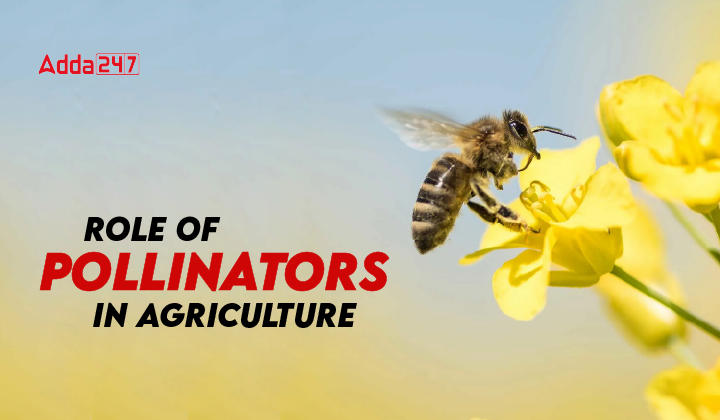Pollinators in Agriculture
Pollinators play a critical role in agriculture by facilitating the reproduction of many flowering plants, including numerous crops that are essential for human food production. In the pollination process, the pollinators transfer the pollen from the male flower (anther) to the female flower (stigma). It is very crucial in the formation of seeds and fruits in many crop plants of agriculture.
Pollinators are the intermediary’s body of pollination that carries the pollen from the male reproductive organs of the plant to the female reproductive organs.
What is Pollination
Pollination is the process in which pollen has been transferred by the pollinators from male to female flowers for the fertilization process. Pollination is the process of fertilization in which pollen has to be transferred by the pollinators from male to female flower plants.
Types of Pollination
There are two to three types of pollination processes are there in agriculture which are listed below:
1. Self Pollination.
2. Cross-pollination.
3. Often Cross-Ppllination.
Types of Pollinators
Several types of pollinators play crucial roles in agricultural systems by facilitating the pollination process for various crops. These pollinators can be categorized based on their characteristics and the methods they use for pollination. Here are some of the main types of pollinators in agriculture:
1. Insects
Bees: Bees are among the most efficient and effective pollinators. Both wild and domesticated bee species, such as honeybees and solitary bees, visit flowers to collect nectar and pollen. They inadvertently transfer pollen between flowers as they forage.
Butterflies: Butterflies are colourful pollinators that are attracted to brightly coloured flowers. They have a relatively weak flying capability and tend to visit a few flowers during each foraging trip.
Flies: Various fly species, including hoverflies and flower flies, are important pollinators. They are attracted to flowers with a strong odour and often feed on nectar and pollen.
Beetles: Some beetles play a role in pollination, particularly in certain types of plants. Beetles are usually attracted to large, bowl-shaped flowers with strong scents.
2. Birds
Hummingbirds: Hummingbirds are known for their hovering flight and ability to feed on nectar. They have long bills and specialized tongues that allow them to access nectar from deep within flowers. They are important pollinators for flowers with tubular shapes.
Bats:
Nectar-Feeding Bats: In some regions, nectar-feeding bats are important pollinators, particularly for night-blooming flowers. These bats have long tongues and are attracted to flowers with pale or white colours and strong scents.
Wind
Anemophilous Plants: While not animals, wind can also be a pollinator for certain plants. Wind-pollinated plants produce large quantities of lightweight pollen that is carried by the wind to nearby flowers. Examples include grasses, many cereal crops, and trees like oak and pine.
3. Other Insects and Animals
Other insects like ants, wasps, and certain beetle species may also contribute to pollination, although their roles might be less prominent compared to bees and butterflies.
The specific types of pollinators present in a given agricultural setting can vary depending on factors such as geographical location, climate, the types of crops being grown, and the availability of natural habitats. Maintaining a diverse range of pollinators is crucial for ensuring effective pollination and agricultural productivity. Promoting habitat diversity, reducing pesticide use, and providing suitable nesting sites are important steps in supporting various pollinator species in agricultural landscapes.
Role of Pollinators In Agriculture
The importance of pollinators in agriculture cannot be overstated. Pollinators play a vital role in the successful reproduction of many crops, contributing to increased yield, quality, and genetic diversity. Here are some key reasons why pollinators are crucial for agriculture:
- Increases Crop Yield: Pollination leads to more efficient fertilization in plants, resulting in higher fruit and seed production. Crops that are effectively pollinated generally have larger and more abundant fruits and seeds, leading to increased crop yields.
- Improves Crop Quality: Pollination can enhance the quality of fruits and seeds. Properly pollinated crops tend to have better color, size, shape, and taste. This is particularly important for the marketability and consumer appeal of agricultural products.
- Creates Genetic Diversity: Cross-pollination, facilitated by pollinators, promotes genetic diversity within plant populations. This diversity is essential for developing resilient and adaptable crop varieties that can better withstand pests, diseases, and changing environmental conditions.
- Crop Variety Diversification: Many crops are dependent on pollinators, including a wide range of fruits (e.g., apples, berries, melons), vegetables (e.g., cucumbers, tomatoes), nuts (e.g., almonds, cashews), and oilseeds (e.g., sunflower). Pollinators contribute to the diversity of crops available for human consumption.
- Economic Value: The economic value of pollinator-dependent crops is substantial. Insect-pollinated crops contribute billions of dollars to global agricultural economies annually. The availability of these crops is essential for the livelihoods of farmers, as well as for local and global food security.
- Ensures Food Security: Pollinator-dependent crops are critical components of human diets. Without adequate pollination, the availability of nutritious and diverse food options could decline, leading to potential nutritional deficiencies and food shortages.
- Supporting Livelihoods: Many small-scale farmers around the world rely on pollinator-dependent crops for their income and sustenance. Pollinator services directly impact the livelihoods of these farmers and their communities.
- Biodiversity and Ecosystem Health: Pollinators support biodiversity by enabling the reproduction of various plant species. This, in turn, sustains ecosystems and provides habitat and food for other wildlife. Healthy ecosystems contribute to overall environmental balance and resilience.
Disadvantages of Pollinators
While pollinators offer numerous advantages to agriculture and ecosystems, there can also be some potential disadvantages associated with their presence or activities. It’s important to note that these disadvantages are context-dependent and might not apply universally. Here are a few potential disadvantages of pollinators:
Cross-Pollination in Monoculture Farms
In monoculture farming systems where a single crop is grown over large areas, cross-pollination by pollinators can lead to unwanted mixing of genetic traits. This might reduce the uniformity of the crop and complicate seed production for commercial purposes.
Spread of Plant Diseases
Pollinators can inadvertently spread plant diseases while visiting multiple flowers or plants. These diseases can negatively impact the health and yield of crops and vegetation.
Competition for Resources
In some cases, pollinators can compete with each other for limited resources like nectar and pollen. This competition might lead to reduced efficiency in pollination or affect the reproductive success of certain plant species.
Pollination Services’ Dependence
Overreliance on managed pollinators, such as honeybees, can lead to concerns about their health and potential decline due to factors like colony collapse disorder. The dependence on a single pollinator species can make agricultural systems vulnerable.
Nuisance or Economic Impact
In certain situations, pollinators like bees and wasps can become a nuisance to humans, particularly in urban areas. Bee swarms or wasp nests near human habitation can pose safety risks.
Seed Contamination
For crops grown for seed production, cross-pollination with related weed species can lead to the development of hybrid seeds that are not true to the intended crop variety. This can result in seed contamination.
Predation and Parasitism
Some insects, like certain parasitic wasps, prey on or parasitize pollinators. This can reduce the populations of valuable pollinators and affect their effectiveness in the ecosystem.
Pollinators as Vectors for Pests
In some cases, pollinators can inadvertently introduce pests to new areas by transporting pests from one plant to another. This can lead to the spread of plant diseases and pests.
Competition with Native Species
Introduced or invasive pollinator species can outcompete native pollinators for resources and potentially disrupt local ecosystems.
Habitat Degradation
The presence of managed pollinators, especially in large-scale monoculture operations, can sometimes lead to habitat degradation due to the removal of natural vegetation to create space for crops.
Future Challenges and Opportunities of Pollinators in Agriculture
The future of pollinators in agriculture faces both challenges and opportunities. As we navigate issues such as environmental changes, habitat loss, and agricultural practices, there are several key challenges and corresponding opportunities that need to be addressed
Challenges
Pollinator Decline: Many pollinator species, particularly bees, are facing population declines due to factors like habitat loss, pesticide exposure, diseases, and climate change. This decline poses a significant threat to agricultural productivity and ecosystem health.
- Habitat Loss: Urbanization, intensive agriculture, and other land-use changes lead to the loss of pollinator habitats. Fragmentation and degradation of natural habitats can reduce the availability of foraging and nesting sites for pollinators.
- Pesticide Use: Pesticides, particularly neonicotinoids, can harm pollinators when used improperly. Reducing pesticide exposure while maintaining effective pest control is a challenge that requires innovative solutions.
- Climate Change: Climate change can disrupt the timing of flowering and pollinator emergence, affecting the synchronization between plants and their pollinators. Extreme weather events and changing temperature patterns also impact the availability of resources for pollinators.
- Invasive Species: Invasive plant and animal species can outcompete native species and disrupt existing pollination networks. Invasive plants might not provide the same quality of resources to pollinators.
Opportunities
Conservation Efforts: Increasing awareness about pollinator decline and the importance of their conservation provides an opportunity to engage individuals, communities, and policymakers in supporting pollinator-friendly practices and policies.
Habitat Restoration and Creation: Restoring natural habitats, creating pollinator-friendly gardens, and establishing wildlife corridors can provide essential habitats for pollinators in both rural and urban environments.
Sustainable Agriculture Practices: Implementing agroecological practices that reduce pesticide use, promote biodiversity, and enhance ecosystem services can benefit both pollinators and agricultural productivity.
Pollinator-Friendly Land Use Policies: Governments and agricultural institutions can develop policies that encourage the integration of pollinator habitats into farming landscapes, promoting habitat connectivity and diversity.
Technology and Research: Advances in technology, such as remote sensing and DNA barcoding, offer opportunities to monitor pollinator populations and behaviour more effectively, aiding in conservation efforts.
Native Plant Promotion: Promoting the use of native plants in landscaping and agriculture can provide pollinators with suitable food sources and nesting sites, as native plants are often well-adapted to local ecosystems.
Public Awareness and Education: Educating the public about the importance of pollinators and how individuals can contribute to their conservation can create a groundswell of support for pollinator-friendly practices.
International Collaboration: International efforts and agreements can help address global challenges to pollinator conservation, such as the decline of migratory pollinators like monarch butterflies.




 Gauhati High Court Recruitment 2025 Noti...
Gauhati High Court Recruitment 2025 Noti...
 Gauhati High Court JAA Salary 2025, Perk...
Gauhati High Court JAA Salary 2025, Perk...
 DSSSB Jail Warder Previous Year Question...
DSSSB Jail Warder Previous Year Question...
 Adda247 Job portal has complete information about all Sarkari Jobs and Naukri Alerts, its latest recruitment notifications, from all state and national level jobs and their updates.
Adda247 Job portal has complete information about all Sarkari Jobs and Naukri Alerts, its latest recruitment notifications, from all state and national level jobs and their updates.